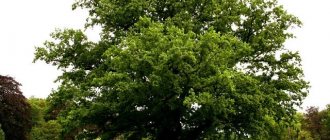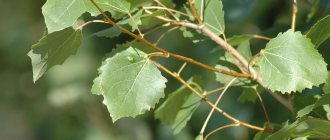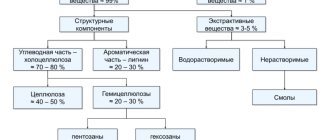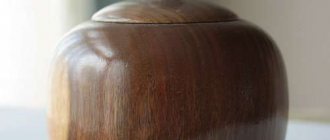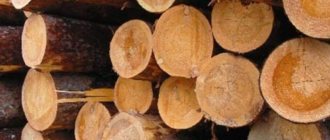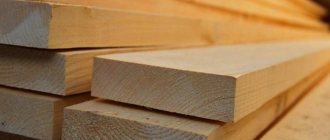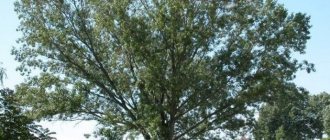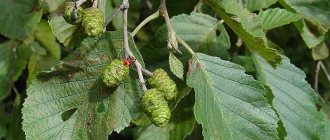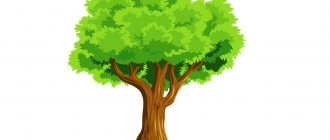Not every owner of a home bath can afford to use an abash for a bath. There are many restrictions on the use of various exotics in the steam room and washroom, but the mass use of new material is limited primarily by price. Apparently, there is something especially valuable and attractive in the texture of abasha wood, if over the past five years the demand for cladding has caught up with traditional linden and cedar.
What is abash
This African oak has many other names - abachi, samba, ayous, abacha, etc. Belongs to the malvaceae family. The valuable wood of the abash tree for baths is durable, soft and resistant to shape. The material can range in color from pale yellow to off-white. The wood has an even, fine texture; there are barely noticeable stripes along the radial cuts.
This African bath tree grows in equatorial forests. Its height reaches 40 meters, and its trunk diameter is 3 meters. Since the crown on it is located only at the very top, there are no knots on the trunk. This circumstance makes the work of carpenters and joiners easier.
Despite the significant cost of wood, abash is very popular. This is an elite material that can be compared in value to mahogany, used in the decoration of apartments and houses. Abashi wood will cost much more than traditional wood species. The reason for the high cost is the need to transport the material from the African continent.
Abashi
50-meter tree Triplochiton hard resin
or
Abashi (lat. Triplochiton scleroxylon) is a monotypic genus of flowering plants of the Malvaceae family (Malvaceae).
A woody plant common in tropical Africa. Previously, the genus Triplochiton was placed in the subfamily Sterculiaceae of the family Malvaceae (this subfamily was also sometimes separated into a separate family), but now the genus Triplochiton is classified in the subfamily Helicteroideae of the family Malvaceae.
The wood of this tree is also known as Abacha
, in Nigeria it is called
Obeche
, in Ghana -
Wawa
, in Cameroon -
Ayous
, and in Côte d'Ivoire -
Samba
.
Growth
Abashi is found in the tropical rainforests of most West African countries. Places of greatest concentration: the countries of Ghana and Congo.
Botanical description
Abash is light-loving, grows alone and apart from other trees - there is always free space around it in the forest.
A specimen of
Triplochiton scleroxylon
, from Bia National Park, Ghana
Appearance and sheet
Triplochiton scleroxylon is a fast-growing, evergreen, mostly deciduous large tree. It usually grows to 40–45, sometimes up to 50 m, and the trunk diameter is usually about 1.5 meters. Very straight and cylindrical, often angular.
The trunk of older specimens is usually branchless up to a height of 30 meters and has powerful buttresses (board-shaped roots) that reach a trunk height of about 8 meters. The bark is ash-gray or yellowish-brown, 7 to 30 mm thick when young, smooth, and then scaly and cracked. Young trees have a cylindrical crown down to the base. Later, the trees have a high, dense, spherical crown with spreading branches, which is preserved only in the upper part, due to which the trunk is devoid of numerous knots.
Alternating leaves arranged on branches, sparsely petiolate from 1.5 to usually 3 to 10 cm in length. A simple leaf width with a length and width of 10 to 20 cm is bifurcated by hand, with five to seven leaf lobes with an arrow-shaped and five-pointed base; they are often split more and deeper on young trees. The ovoid, triangular or oblong and entire angular lobes of the leaves have a rounded, blunt and pointed upper end. The leaf surfaces initially have brown, star-shaped hairs, but soon become bald. Secondary leaves, 2 to 4 cm long, fall off early, leaving a ring trail of leaves.
Inflorescence and flowering
The main flowering period is during the dry season. Trees develop their first flowers only at the age of 15 to 20 years. The inflorescence is 4 to 10 cm long with a densely pubescent axis of the inflorescence. The flower stems are 4 to 5 mm long and pubescent.
The flower-bearing and short-stemmed flowers are radially symmetrical and five-pointed with a double floral sheath. Flowering stems sit on a “hinge”. The triangular sepals, about 7 mm long, are fused to a third of their length and have brown, star-shaped hairs. The orderly, dense, silky-hairy, white, and at their base red-violet, spreading crown leaves are about 1 cm long and wide. From 30 to 46 stamens of equal length grow together in pairs at their base. This carpel consists of five stamens. There are five separate, fused and upper fruiting leaves. Cross pollination.
Fruit
Mature fruits are brown to reddish brown in color. The schizocarp (fractional capsule) disintegrates from one to five individual winged seeds (like maple). The lionfish are about 2 cm long and about 1 cm wide. The wings are oblong-ovate with a thickened edge, with a length of 4 to 6 cm and a width of 1.2 to 2 cm.
The number of chromosomes is 2n = 40.
Properties of wood and application
Green week in exhibition halls in Berlin. Giant tree trunk from Nigeria weighing 6.3 tons
Wood sample
The structure and color are uniform - the core and sapwood are practically no different from each other, the wood grain has delicate light shades from milky white to cream and pronounced yellow. Due to the absence of knots and curls on the trunk, the texture and pattern of the material are fine-celled. Colors darken slightly with age.
The wood is soft, durable, and dimensional stable. Suitable for various types of processing and polishing.
Sanded veneer
Veneer under varnish
End of the board
The end of the board is wood fibers, taken away. 10x
For the first time, the unique qualities of lumber were noted in the 70s of the 19th century. Swedish and Finnish builders liked it due to its unique thermal conductivity. It turned out that the African abash does not heat up, even if the ambient temperature is about 100°C. This property allows the wood to be used for interior decoration of baths, steam rooms, and saunas. The trim and shelves made of abasha do not cause burns when touched.
The surface of the material is at ambient temperature, but heat does not accumulate inside.
If you put your hand on the abash, it will be hot in the first seconds, then the wood will adjust and become the same temperature as the skin. Similar properties are provided by Abashi's high porosity, which is necessary in a very humid and hot equatorial climate. In addition, this lumber quickly releases moisture, but slowly absorbs it. If you wet it across the fibers, the water will not be absorbed beyond the surface.
It is also used to make table tennis racket bases.
Properties of African oak wood
The main property that distinguishes abash for a bath is the low thermal conductivity of its wood. Thanks to this feature, African oak boards will not burn human skin during bath procedures.
In addition to this quality, abasha material has a number of other useful characteristics:
- It does not release resinous substances even when heated to high temperatures.
- Over a long period of time it is not deformable.
- It is resistant to various mechanical influences.
- Lumber is not subject to shrinkage.
- When the humidity level in a room reaches 12%, the wood still remains dry. Even from the end side, abasha products slowly absorb moisture. For example, aspen boards get wet much faster.
- Despite the high density of wood, African oak can be processed without problems, so you can work with it yourself.
- It easily accepts screws for fastening, and the use of nails, if driven in, does not lead to cracks.
- Can be tinted without any problems.
- Does not change color during long-term use.
- When a person’s body touches wood, the material immediately takes on its temperature.
- When creating the interior of a room, it combines perfectly with other types of wood.
By the way, African oak wood can be used not only in arranging baths, but also in apartments and houses. In a building where the finishing is made of abasha, it will always be warm in winter, and not hot in summer due to the low thermal conductivity of the material.
African oak has the following technical characteristics:
- specific gravity is 0.25 - 0.55 g/cm²;
- the density in the freshly cut state is 550-700 kg/m³, and in the dry state - 390 kg/m³;
- easy to glue;
- does not deform when dried.
Wood has few disadvantages:
- high price, so an abasha steam room will be an expensive pleasure;
- a small amount of high-quality material enters the domestic market;
- The areas on which these trees grow tend to decrease.
Technical and operational capabilities of abasha wood
Abashi wood has unique technical characteristics:
- density up to 420 kg/m3;
- withstands compression loads up to 280 kg/cm2;
- on bends withstands loads up to 528 kg/cm2.
After heat treatment at a temperature of 230 °C, the wood changes color and does not rot.
Drying
“African maple” is very critical to drying conditions, but it dries quickly. If drying is carried out without good air circulation, pathogenic microflora affects the workpiece. Before drying, the wood is kept for at least two days.
The sawn tree has a specific smell, but during the drying process it disappears.
Dried wood acquires new qualities:
- Resistant to direct contact with steam and water.
- Light weight. For comparison: a dry cubic meter of abashi weighs no more than 420 kg, while oak wood weighs 700 kg.
Grade
Abashi wood is of high grade. Products made from it have no knots or defects. They have a uniform texture and color, so they look very attractive.
All products made from abashi are classified as extra class. Larch, cedar and alder are completely combined with African maple wood during finishing work.
Making bathhouse shelves from abasha
If you plan to build a bathhouse or sauna from abasha, you can make cladding from this wood and use it in the construction of furniture and shelves. The finishing material is purchased in the form of lining, and the shelves are made independently.
A design drawing is first drawn up taking into account the required parameters:
- The length of the bench should be at least 150-180 centimeters, the height at least 20 centimeters from the floor surface and the distance between levels at least 40-60 centimeters.
- From the ceiling to the upper bench the gap cannot be less than 100-120 centimeters.
- Depending on the size of the steam room, the width of the shelves should be 40-150 centimeters (for more details: “What size of shelves should be made in the steam room - tips from practice”).
The work is done in the following sequence:
- First, the boards and beams are sanded, smoothing out sharp corners.
- Assembling the frame. They construct vertical support posts from timber with a cross-section of 5x7 centimeters and fasten them with horizontal strapping. They are installed at intervals of 50-60 centimeters so that the flooring does not sag during operation.
- Then benches are made from thin boards, fixing them to the frame with a gap of 1-2 centimeters. To ensure moisture drainage, the shelves are assembled with an inclination of several degrees.
- The structural parts are connected with wooden wedges, which are driven into pre-prepared holes. If self-tapping screws are used, they should be deepened into the wood by 5-6 centimeters to prevent skin burns.
As can be seen from the information provided in the article, African oak has become a popular material for saunas and baths, since this wood has no equal in terms of performance qualities.
History of world distribution
As is already known, the homeland of Abash is Africa. It was discovered by the Scandinavians, the Finns and the Swedes, for the rest of the world. They were once in search of new types of finishes for steam rooms, so they highly appreciated this tree for its unique characteristic of not accumulating heat, which is incredibly valuable for interior wall cladding.
At the beginning of the 20th century, African oak also caught the fancy of furniture designers, who began making interior items from it. Demand emerged, and global procurement volumes increased several times. It entered the Russian market in the 90s of the last century, receiving high appreciation for:
- uniform texture (there are no traces of knots on the trunks);
- delicate shades (abashi wood conveys a spectrum from straw yellow to whitish cream);
- wide coverage of profiles, giving a start to the creativity and imagination of designers;
- high manufacturability (easily amenable to any carpentry work and polishing);
- maintaining the original appearance for a long time without deformation;
- combination with other species (it is especially good in combination with contrasting Canadian cedar).
Abash for a bath: review, features, installation technology and reviews
The assortment of the modern market is constantly being replenished with new and new materials, which are used today in construction not only by professionals, but also by private craftsmen. The list of traditional and budget solutions for baths includes products made from such types of wood as:
Recently, this list has been supplemented with abash, which can be called a rare variety.
Abash is a giant tree that grows in the equatorial forests of Africa. There is a crown only at the very top, so the trunk is free of knots. This cannot but please joiners and carpenters. The wood can range in color from creamy white to straw yellow. There is not much difference between heartwood and sapwood.
This wood appeared in Russia in the 90s. Its cost is quite high, but it gained popularity among consumers very quickly. Abash is for a bathhouse what mahogany is for a house. This material is elite and costs more than traditional wood types. Such a high cost is due to the place of growth, because the path to Russia is not close.
Where does abash grow?
It is distributed in the tropical part of the African continent, in the western forests, closer to the equatorial region. Represents a free-standing tree that is valued throughout the world for its phenomenal qualities, shaped by the influence of the local ecosystem.
Abash tree from bottom to top
It can stretch up to 40 meters with a trunk diameter of 2 to 3 meters. That is, this is a real giant. The crown is concentrated only on the apical part, so the main trunk is free of knots, which is convenient for processing and sawing.
Impressive volumes of this wood remain in the Congo, but the risky political environment in this area of the country makes exporting the wood incredibly dangerous. Some reserves are present in Ghana: restoration of its plantings is actively underway there.
Features of wood
Abash is excellent for baths, because it has low thermal conductivity, thanks to which the boards do not burn human skin even under the influence of high temperatures in a sauna or bathhouse. However, this breed also has many other useful properties, among them the following should be highlighted:
- resistance to mechanical stress;
- resistance to shrinkage;
- compatibility with wood of other types;
- color constancy even after long-term use.
When heated, the material will not release resin. It does not deform for a long time. The wood will remain dry even if the room humidity reaches 12%. The material slowly absorbs moisture from the ends, but if we compare it with aspen boards, the latter get wet quite actively.
Abash (this indicator is of great importance for a bath) has a high density, but is easy to process, so it is easy to manipulate. Screws go into wood well. You can hammer nails without fear of the material becoming cracked. It can be tinted. This type of wood can be used not only for cladding the internal surfaces of a sauna or bathhouse, but also for finishing a house. The material has low thermal conductivity, so the rooms will be cool in summer and warm in winter.
Abash for baths has many positive characteristics that generate appropriate reviews. For example, the maximum load on the material can reach 280 kg per square centimeter. At bends this value is 528 kg per square centimeter. Consumers also like the high density, which reaches 390 kg per cubic meter.
Lining installation technology
Abash lining is perfect for a bathhouse. You can install it yourself. To do this, you can use slats. They allow you to cover walls quite quickly and efficiently. If you need to update the surface, you can do it without difficulty.
Each subsequent lining board is installed in the groove of the previous one, and a galvanized clamp, which is a special clamp, is put on the protrusion. It is fixed to the sheathing batten with a screw and a self-tapping screw or a galvanized nail. Abashi for a bath, the price of which is quite high, is installed using a certain technology. At the final stage, it involves trimming the last product so that the craftsman has the opportunity to freely insert the panel into the remaining space. Fastening is carried out with nails or self-tapping screws.
The second option for installing the lining
Today, there are several known ways to install lining in a bathhouse. You can use another technology that involves fastening the last elements in such a way that the fastening site remains open.
Holes for the heads of self-tapping screws should be drilled in the product. It is necessary to deepen it by 1/2 of its thickness. Once the screw is in, the hole is closed with a wooden dowel and sanded down. It is important to take into account during the operation of the steam room that the attachment points may dry out and become more noticeable.
Using nails during installation
Abash lining for a bath, the price of which is 270 rubles. per linear meter or 3240 rubles. per square meter, can be installed using nails. However, it should be borne in mind that this approach quite often leads to marriage. It is difficult to imagine that not a single element will be damaged in this case.
If the length of the lining is 2.5 m, then you will have to hammer in approximately 6 nails with a product width of 100 mm. If you are going to cover a wall whose length is 10 m, then you will need 600 pieces. The master must have special skills to carry out the work without defects. The nail should be inserted into the groove and driven further into the mounting rail. The cap is recessed inside with a hammer so that it does not interfere with the installation of the next element.
When choosing abashi for a bath, the price should definitely be taken into account. For example, an extra grade thermal material will cost you 325 rubles. per linear meter or 3900 rubles. per square meter. In this case, as in the previous one, we are talking about products whose dimensions are 12 x 92 mm.
Pros and cons of abash lining for a bath
During the construction of a bathhouse, a considerable amount of time is devoted to its improvement. In addition to the fact that no unpleasant sensations should occur when touching the walls in the steam room, the decoration, as well as the interior of the bathhouse, should please the owner’s eye. That is why experts recommend using abash lining, which today competes with linden.
General information and features of Abashi
Abashi is a giant tree (in other words, African oak) that grows in the equatorial forests of Africa. Its height can reach up to 40 meters, thickness - up to 3 meters. The crown is located exclusively at the top; accordingly, the trunk is completely free of knots, which in turn pleases carpentry specialists.
The color of the tree can be either straw yellow or creamy white. Note that there is no sharp difference between sapwood and heartwood. It is immediately necessary to draw your attention to the fact that lining for an Abashi bathhouse is the same as mahogany for a house. In other words, this is an extremely elite and noble material, the cost of which significantly exceeds traditional wood species. Its high prices are primarily related to the place in which the tree was grown.
It should be noted that the use of traditional types of wood can cause burns when touching the surface of hot wood. That is why Finnish specialists became interested in using Abashi wood in the bath industry, supplying construction wood to European countries.
Advantages
Since Abashi wood comes from a hot and very humid climate, Abashi lining for a bathhouse is characterized by the following set of advantages:
- Low level of thermal conductivity, compared to lining made from any other material;
- Ease of processing: the softness of the wood makes it easy to plan, saw and drill without any fear of chipping or cracking. In addition, the individual parts are quite easily fastened together;
- Low density (lightness of the material);
- Exceptional strength of abash lining for baths;
- Form stability. During direct use of the product, the material does not deform or shrink. Thus, it becomes possible to use it for finishing surfaces that function in the most difficult conditions;
- The complete absence of knots or any other defects makes this lining attractive in its external characteristics, smooth and pleasant to the touch.
Reference! Please note that when the wood and floorboards in the bathhouse get wet, its surface does not become slippery. Therefore, such material can be used to construct a bath floor in a washing room.
Flaws
It should be noted that Abashi wood has significantly fewer disadvantages than advantages, which, of course, cannot but rejoice. So:
- High cost of abash paneling for a bathhouse;
- Supply of small quantities of high-quality wood to domestic markets;
- Every year, the growth rate of the Abash tree is declining at a significant rate.
Based on the above material, you will be able to make your own decision about the wisdom of using abash lining for a bathhouse. In conclusion, I would like to note that the excellent properties of this material have increased its popularity and, accordingly, a good reputation in the building materials market.
The price of an abash, is it worth the candle?
To finish the bath, various forms of material are used, from slats and veneer to solid boards and timber. Most often, abashi for baths are sold at retail in the form of finished polished products - cladding and timber for sunbeds. The average cost of bench timber for a bathhouse, with a cross-section of 90x19 mm, is 5-6 dollars per meter, while lining with end locks, 85 mm wide, costs from 90 dollars per m2.
African “spill” Abashi timber and boards of similar sizes in wholesale cost 4-5 dollars per linear meter. For comparison, the price tag for a heat-treated version of an abashi board, 90 mm wide, starts at $10 per meter of length. Asian Abacha is usually quoted 15% cheaper than African Abacha.
When selecting abasha cladding for a bathhouse, you should remember that not all miracle wood offered on the market for construction and cladding products is the same in its characteristics. The African abasha tree grows up to 30 m tall, with a trunk girth of up to one and a half meters. Due to its enormous size, the abashi tree is cut and cut into a rough board directly at the harvesting site, so one wholesale batch may contain abashi boards with different characteristics.
For bath chairs and abash shelves, a board with maximum hardness is selected. It is best to select soft material for lining and finishing strips for cladding bath walls. It is difficult to find out exactly what material is in the wholesale packaging of abashi boards. No one will allow you to unpack a pack, sort and select a board before purchasing, so purchasing materials from abash wood for a bathhouse remains in many ways a lottery.
Only a professional who has been working with wood for many years can distinguish the difference in material. The average buyer, as a rule, purchases small quantities of lining and timber at retail, so he begins to understand the differences in characteristics only 2-3 years after intensive use of the bathhouse and steam room.
